From inside (document excerpt):
STIHL MS 361 C Instruction Manual Manual de instrucciones Warning! To reduce the risk of kickback injury use STIHL reduced kickback bar and STIHL RM2, RMC3 (0,325 “) or RM2, RSC3 (3/8 “) chain depending on sprocket or other available low kickback components. Advertencia! Para reducir el riesgo de lesionarse como resultado de un culatazo, utilice la barra de contragolpe reducido y la cadena RM2, RMC3 (0,325 pulg) o RM2, RSC3 (3/8 pulg) de STIHL, dependiendo de la rueda dentada usada y de otros componentes reductores de contragolpe.
Read and follow all safety precautions in Instruction Manual improper use can cause serious or fatal injury. Lea y siga todas las precauciones de seguridad dadas en el manual de instrucciones el uso incorrecto puede causar lesiones graves o mortales. English / USA Contents Allow only persons who understand this Manual to operate your chainsaw. To receive maximum performance and satisfaction from your STIHL chainsaw, it is important that you read and understand the maintenance and safety precautions, starting on page 4, before using your chainsaw. Contact your STIHL dealer or the STIHL distributor for your area if you do not understand any of the instructions in this Manual. Printed on chlorine-free paper. Printing inks contain vegetable oils; paper can be recycled. Secondary Chain Braking System 2 Guide to Using this Manual 3 Safety Precautions and Working Techniques . 4 Mounting the Bar and Chain (Side chain tensioner) 27 Mounting the Bar and Chain (Quick Chain Tensioner) . 28 Tensioning the Saw Chain (Side chain tensioner) 31 Tensioning the Saw Chain (Quick chain tensioner) 32 Checking Chain Tension . 32 Fuel 32 Fueling 33 Chain Lubricant 35 Filling Chain Oil Tank 35 Checking Chain Lubrication . 36 Chain Brake . 36 Winter Operation 38 Information Before You Start 39 Starting / Stopping the Engine 39 Operating Instructions 43 Oil Quantity Control 44 Taking Care of Guide Bar . Air Filter System . Cleaning the Air Filter . Motor Management Adjusting the Carburetor Spark Arresting Screen in Muffler Checking the Spark Plug Replacing Starter Rope and Rewind Spring . Storing the Machine . Checking and Replacing Chain Sprocket . Maintaining and Sharpening Saw Chain Maintenance Chart . Main Parts of the Saw Specifications . Special Accessories . Ordering Spare Parts . Maintenance and Repairs STIHL Incorporated Federal Emission Control Warranty Statement Trademarks BA_SE_144_004_01_05.fm !Warning! Because a chainsaw is a high-speed wood-cutting tool, some special safety precautions must be observed as with any other power saw to reduce the risk of personal injury. Careless or improper use may cause serious or even fatal injury. STIHL’s philosophy is to continually improve all of its products. As a result, engineering changes and improvements are made from time-to-time. If the operating characteristics or the appearance of your chainsaw differs from those described in this Manual, please contact your STIHL dealer for information and assistance. ANDREAS STIHL AG & Co. KG, 2008 0458 214 8621 A. M0,5. D8. PM. Printed in USA STIHl MS 361 C 1 English / USA Secondary Chain Braking System This STIHL chainsaw is equipped with a chain brake system that can be activated in three different ways. As before, the chain brake can be activated by the inertia of the front hand guard in certain kickback situations or manually by pushing the front hand guard toward the bar nose. In both of these cases the brake, once activated, is designed to bring the chain to a standstill within fractions of a second. In addition, there is a secondary system that is designed to stop chain rotation within a second of you letting go of the rear handle. The locked chain is not released again until you press down the throttle trigger interlock lever to operate the throttle. The chain brake can be activated in three ways: 2 1 150BA000 KN 1 2 By inertia in certain kickback situations Manually via the front hand guard The activating mechanism for the secondary chain braking system is integrated in the throttle trigger interlock lever (rear handle). One of the big advantages of this system is that the saw chain is automatically locked in position for engine starts and when carrying the running saw by the front handle (with the rear handle released). To reduce the risk of personal injury or property damage during cutting, observe the characteristics that make this saw different from saws not equipped with a secondary chain braking system. Before operating the chainsaw for the first time, make sure you are familiar with how the rear-handle activation works. Pay special attention to the chapters “Chain Brake ” and “Starting/Stopping the Engine “. 3 Manually by releasing the rear handle 2 MS 361 C English / USA Guide to Using this Manual Pictograms All the pictograms attached to the machine are shown and explained in this manual. The operating and handling instructions are supported by illustrations. In addition to the operating instructions, this manual may contain paragraphs that require your special attention. Such paragraphs are marked with the symbols described below: Warning where there is a risk of an accident or personal injury or serious damage to property. Caution where there is a risk of damaging the machine or its individual components. Note or hint which is not essential for using the machine, but may improve the operator’s understanding of the situation and result in better use of the machine. Note or hint on correct procedure in order to avoid damage to the environment. Equipment and features This instruction manual may refer to several models with different features. Components that are not installed on all models and related applications are marked with an asterisk (*). Such components may be available as special accessories from your STIHL dealer. Symbols in text The individual steps or procedures described in the manual may be marked in different ways


 STIHL Owners Manual - 1 of 138
STIHL Owners Manual - 1 of 138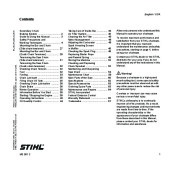 STIHL Owners Manual - 2 of 138
STIHL Owners Manual - 2 of 138 STIHL Owners Manual - 3 of 138
STIHL Owners Manual - 3 of 138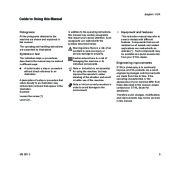 STIHL Owners Manual - 4 of 138
STIHL Owners Manual - 4 of 138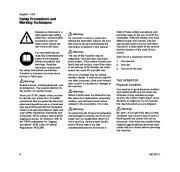 STIHL Owners Manual - 5 of 138
STIHL Owners Manual - 5 of 138 STIHL Owners Manual - 6 of 138
STIHL Owners Manual - 6 of 138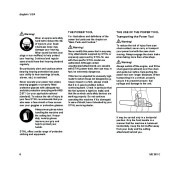 STIHL Owners Manual - 7 of 138
STIHL Owners Manual - 7 of 138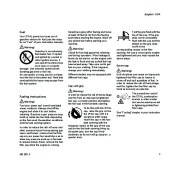 STIHL Owners Manual - 8 of 138
STIHL Owners Manual - 8 of 138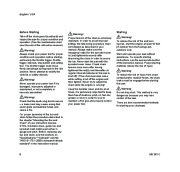 STIHL Owners Manual - 9 of 138
STIHL Owners Manual - 9 of 138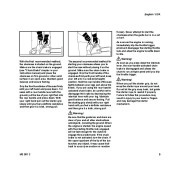 STIHL Owners Manual - 10 of 138
STIHL Owners Manual - 10 of 138